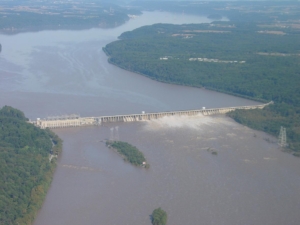UMCES Scientists Find the Bay is More Resilient Than Expected

(Credit: USGS)
Sitting on the lower Susquehanna River, the Conowingo Dam has trapped most of the sediment and nutrients, like nitrogen and phosphorus, in its upstream reservoir, keeping them from flowing into the Chesapeake Bay. Recent concerns about the storage capacity of the dam have raised questions about its potential impacts to downstream Bay ecosystems.
New research from the University of Maryland Center for Environmental Science (UMCES) found that while storm events can cause sediment to flow downstream, the Bay is resilient to these short-term impacts. Cindy Palinkas, the study’s lead author and an associate professor at UMCES, explained the results of the synthesis project. The effort was funded by Maryland Sea Grant, The Grayce B. Kerr Fund, and Exelon through the Maryland Department of Natural Resources.
Sediment flow into the Bay
Scientists looked at four decades of data and synthesized field observations and modeling along the reservoir-Bay continuum to evaluate the potential impacts on Bay geochemistry. They found that most sediment and particulate nutrient impacts occur during high-flow events, such as major storms, which is less than 10% of the time.
While storm events can have major short-term impacts, normal river flows actually carry less sediment now than in the past. “This decrease probably reflects efforts in the watershed to reduce sediment loads through BMPs [best management practices],” explained Palinkas.
Storm event impacts
With increasing intensity and frequency of storm events, there is some concern that these events could send a large amount of pollution down the Bay. Palinkas said, “the Bay is more resilient than we think, it can handle these storm events.” Palinkas provided an analogy to help explain, “If you’re a pretty healthy person, but you get a cold, you can deal with that cold. But if you’re a member of the vulnerable population and you get a cold, that cold would have a bigger effect on your health.”
She explained that even though a lot of sediment goes into the Bay during these events, “if we’re doing all the things we can to maintain Bay health, like the best management practices, we give the Bay its best chance to deal with these storms.”
